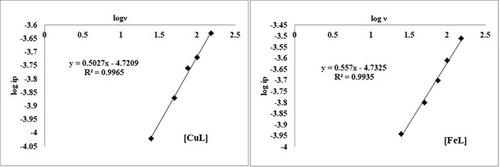当前位置:
X-MOL 学术
›
Electroanalysis
›
论文详情
Our official English website, www.x-mol.net, welcomes your feedback! (Note: you will need to create a separate account there.)
Electrocatalytic Investigations of Cu(II) and Fe(III) Complexes of Salophen Derivative Schiff Bases on the Pencil Graphite Electrode
Electroanalysis ( IF 3 ) Pub Date : 2020-03-17 , DOI: 10.1002/elan.202000053 D. Cakmak 1 , T. Bulut 1 , D. Uzun 2
Electroanalysis ( IF 3 ) Pub Date : 2020-03-17 , DOI: 10.1002/elan.202000053 D. Cakmak 1 , T. Bulut 1 , D. Uzun 2
Affiliation

|
This present study describes a pencil graphite electrode surface covered with Cu(II) and Fe(III) complexes based on Salophen derivative Schiff bases in acetonitrile solution containing LiClO4 as a supporting electrolyte. Cyclic voltammetry method was used for the surface modification procedure with 25 cycle at a sweep rate of 50 mV s−1. Some characterization methods were used to identify of the prepared modified surfaces including cyclic voltammetry (CV), electrochemical impedance spectroscopy (EIS), Ultraviolet‐visible Spectroscopy (UV‐Vis), and Scanning Electron Microscopy/Energy Dispersive X‐ray Spectroscopy (SEM/SEM‐EDX). The catalytic activity of these modified surfaces on the electrochemical oxidation of catechol (CC) was investigated and they compared with each other. The results demonstrated that these modified electrodes showed perfect electrocatalytic activity on the catechol determination, however the modified electrode prepared with the Cu(II) complex has higher catalytic activity than this prepared with the Fe(III) complex thanks to its the lower detection limit.
中文翻译:

Salophen衍生物席夫碱的Cu(II)和Fe(III)配合物在铅笔状石墨电极上的电催化研究
本研究描述了一种铅笔石墨电极表面,该表面覆盖有基于Salophen衍生物Schiff碱的Cu(II)和Fe(III)配合物,该溶液在含有LiClO 4作为支持电解质的乙腈溶液中。循环伏安法用于表面修饰程序,扫描速率为50 mV s -1时具有25个循环。一些表征方法用于鉴定制备的改性表面,包括循环伏安法(CV),电化学阻抗谱(EIS),紫外可见光谱(UV-Vis)和扫描电子显微镜/能量色散X射线光谱(SEM / SEM-EDX)。研究了这些改性表面对邻苯二酚(CC)电化学氧化的催化活性,并将它们进行了比较。结果表明,这些修饰电极在邻苯二酚测定中显示出完美的电催化活性,但是,由于其检测限较低,因此使用Cu(II)配合物制备的修饰电极比使用Fe(III)配合物制备的修饰电极具有更高的催化活性。
更新日期:2020-03-17
中文翻译:

Salophen衍生物席夫碱的Cu(II)和Fe(III)配合物在铅笔状石墨电极上的电催化研究
本研究描述了一种铅笔石墨电极表面,该表面覆盖有基于Salophen衍生物Schiff碱的Cu(II)和Fe(III)配合物,该溶液在含有LiClO 4作为支持电解质的乙腈溶液中。循环伏安法用于表面修饰程序,扫描速率为50 mV s -1时具有25个循环。一些表征方法用于鉴定制备的改性表面,包括循环伏安法(CV),电化学阻抗谱(EIS),紫外可见光谱(UV-Vis)和扫描电子显微镜/能量色散X射线光谱(SEM / SEM-EDX)。研究了这些改性表面对邻苯二酚(CC)电化学氧化的催化活性,并将它们进行了比较。结果表明,这些修饰电极在邻苯二酚测定中显示出完美的电催化活性,但是,由于其检测限较低,因此使用Cu(II)配合物制备的修饰电极比使用Fe(III)配合物制备的修饰电极具有更高的催化活性。


























 京公网安备 11010802027423号
京公网安备 11010802027423号